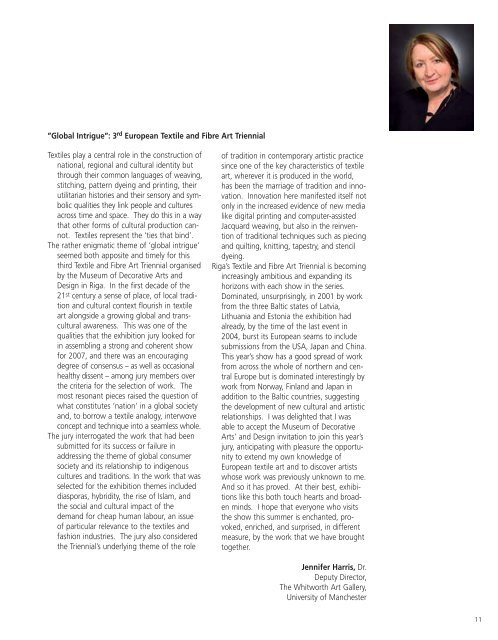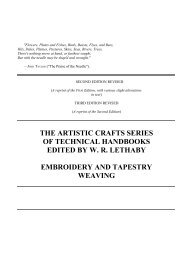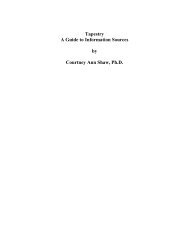3rd European textile and Fibre Art Festival - Catalogue
3rd European textile and Fibre Art Festival - Catalogue
3rd European textile and Fibre Art Festival - Catalogue
Create successful ePaper yourself
Turn your PDF publications into a flip-book with our unique Google optimized e-Paper software.
”Global Intrigue”: 3 rd <strong>European</strong> Textile <strong>and</strong> <strong>Fibre</strong> <strong>Art</strong> Triennial<br />
Textiles play a central role in the construction of<br />
national, regional <strong>and</strong> cultural identity but<br />
through their common languages of weaving,<br />
stitching, pattern dyeing <strong>and</strong> printing, their<br />
utilitarian histories <strong>and</strong> their sensory <strong>and</strong> symbolic<br />
qualities they link people <strong>and</strong> cultures<br />
across time <strong>and</strong> space. They do this in a way<br />
that other forms of cultural production cannot.<br />
Textiles represent the ‘ties that bind’.<br />
The rather enigmatic theme of ‘global intrigue’<br />
seemed both apposite <strong>and</strong> timely for this<br />
third Textile <strong>and</strong> <strong>Fibre</strong> <strong>Art</strong> Triennial organised<br />
by the Museum of Decorative <strong>Art</strong>s <strong>and</strong><br />
Design in Riga. In the first decade of the<br />
21 st century a sense of place, of local tradition<br />
<strong>and</strong> cultural context flourish in <strong>textile</strong><br />
art alongside a growing global <strong>and</strong> transcultural<br />
awareness. This was one of the<br />
qualities that the exhibition jury looked for<br />
in assembling a strong <strong>and</strong> coherent show<br />
for 2007, <strong>and</strong> there was an encouraging<br />
degree of consensus – as well as occasional<br />
healthy dissent – among jury members over<br />
the criteria for the selection of work. The<br />
most resonant pieces raised the question of<br />
what constitutes ‘nation’ in a global society<br />
<strong>and</strong>, to borrow a <strong>textile</strong> analogy, interwove<br />
concept <strong>and</strong> technique into a seamless whole.<br />
The jury interrogated the work that had been<br />
submitted for its success or failure in<br />
addressing the theme of global consumer<br />
society <strong>and</strong> its relationship to indigenous<br />
cultures <strong>and</strong> traditions. In the work that was<br />
selected for the exhibition themes included<br />
diasporas, hybridity, the rise of Islam, <strong>and</strong><br />
the social <strong>and</strong> cultural impact of the<br />
dem<strong>and</strong> for cheap human labour, an issue<br />
of particular relevance to the <strong>textile</strong>s <strong>and</strong><br />
fashion industries. The jury also considered<br />
the Triennial’s underlying theme of the role<br />
of tradition in contemporary artistic practice<br />
since one of the key characteristics of <strong>textile</strong><br />
art, wherever it is produced in the world,<br />
has been the marriage of tradition <strong>and</strong> innovation.<br />
Innovation here manifested itself not<br />
only in the increased evidence of new media<br />
like digital printing <strong>and</strong> computer-assisted<br />
Jacquard weaving, but also in the reinvention<br />
of traditional techniques such as piecing<br />
<strong>and</strong> quilting, knitting, tapestry, <strong>and</strong> stencil<br />
dyeing.<br />
Riga’s Textile <strong>and</strong> <strong>Fibre</strong> <strong>Art</strong> Triennial is becoming<br />
increasingly ambitious <strong>and</strong> exp<strong>and</strong>ing its<br />
horizons with each show in the series.<br />
Dominated, unsurprisingly, in 2001 by work<br />
from the three Baltic states of Latvia,<br />
Lithuania <strong>and</strong> Estonia the exhibition had<br />
already, by the time of the last event in<br />
2004, burst its <strong>European</strong> seams to include<br />
submissions from the USA, Japan <strong>and</strong> China.<br />
This year’s show has a good spread of work<br />
from across the whole of northern <strong>and</strong> central<br />
Europe but is dominated interestingly by<br />
work from Norway, Finl<strong>and</strong> <strong>and</strong> Japan in<br />
addition to the Baltic countries, suggesting<br />
the development of new cultural <strong>and</strong> artistic<br />
relationships. I was delighted that I was<br />
able to accept the Museum of Decorative<br />
<strong>Art</strong>s’ <strong>and</strong> Design invitation to join this year’s<br />
jury, anticipating with pleasure the opportunity<br />
to extend my own knowledge of<br />
<strong>European</strong> <strong>textile</strong> art <strong>and</strong> to discover artists<br />
whose work was previously unknown to me.<br />
And so it has proved. At their best, exhibitions<br />
like this both touch hearts <strong>and</strong> broaden<br />
minds. I hope that everyone who visits<br />
the show this summer is enchanted, provoked,<br />
enriched, <strong>and</strong> surprised, in different<br />
measure, by the work that we have brought<br />
together.<br />
Jennifer Harris, Dr.<br />
Deputy Director,<br />
The Whitworth <strong>Art</strong> Gallery,<br />
University of Manchester<br />
11






